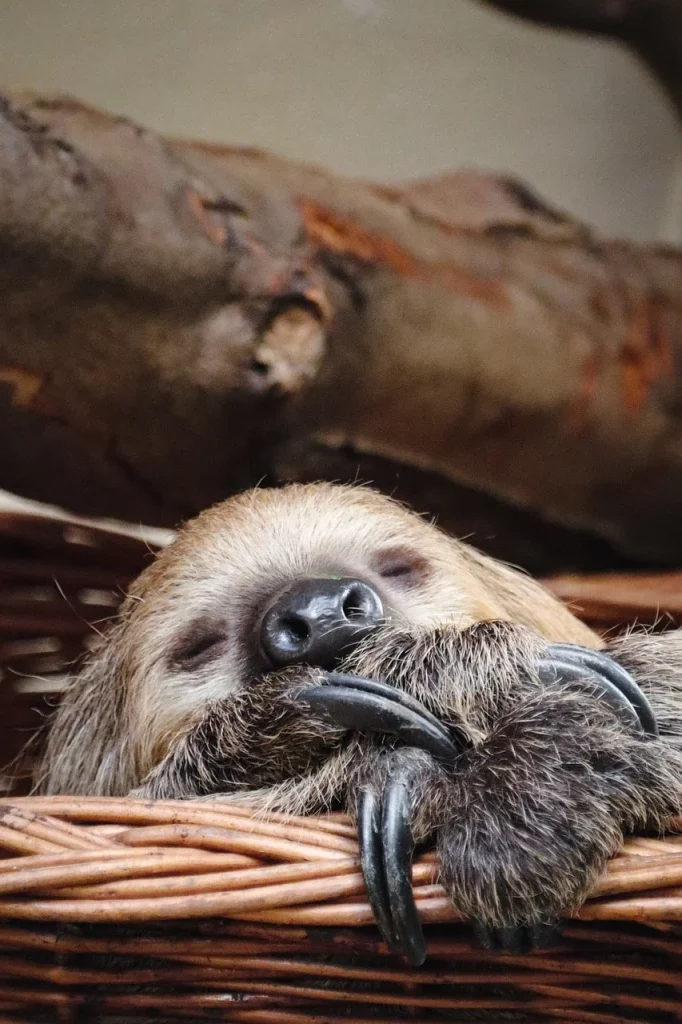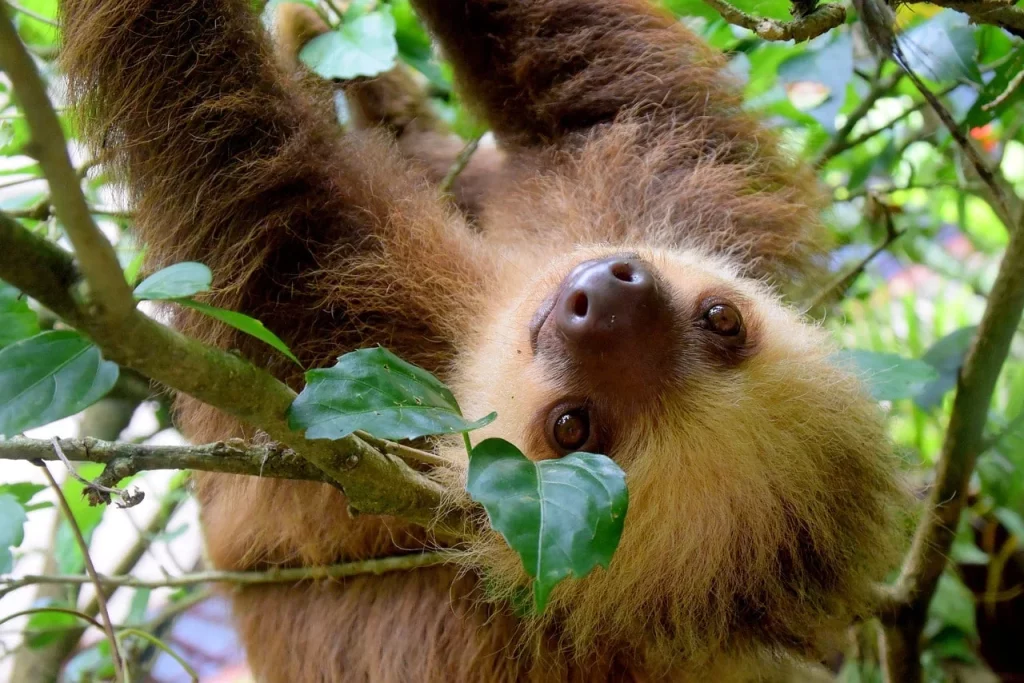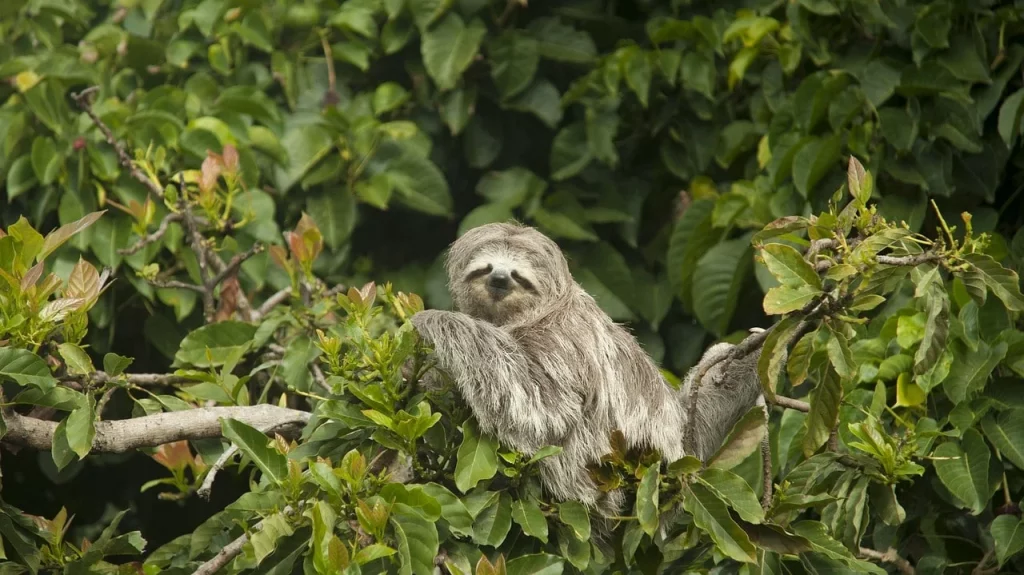Welcome to the slow lane, where the residents are fuzzy, adorable, and take their sweet time doing just about everything. Yes, we’re talking about sloths, the champions of chill in the animal kingdom.
These creatures are so relaxed that they make a snail’s pace seem fast. But there’s more to sloths than just their speed, or lack thereof. From their unique eating habits to their surprising swimming skills, sloths are full of surprises.
Have you ever wondered why sloths are so slow, or why they seem to smile all the time? Stick around as we dive into some interesting facts about these laid-back animals. Are you ready to slow down and learn at a sloth’s pace?
Sloths are the true zen masters of the animal kingdom, embodying the art of doing absolutely nothing.
Bill Murray
Sloth Facts
Before we dive into their world, keep in mind there’s a quiz awaiting at the article’s end. Read carefully to prove your expertise on these fascinating creatures. Don’t disappoint me.
- These creatures take a leisurely approach to life, moving so slowly that algae grows on their fur.
- They can rotate their heads nearly 270 degrees, thanks to extra vertebrae.
- A unique adaptation allows them to hang upside down for long periods without affecting their breathing.
- Their diet primarily consists of leaves, which are not very nutritious, slowing their metabolism.
- Despite their slow movements, they are excellent swimmers, especially in the quest for mates or new habitats.
- These animals have a low metabolic rate, which is why they move slowly and conserve energy.
- They spend most of their lives in the trees, descending only about once a week to defecate.
- Camouflage is key for their survival, as their greenish-colored fur blends perfectly with the rainforest canopy.
- They possess a highly specialized stomach designed to slowly digest the tough cellulose in leaves.
- Predators such as jaguars, snakes, and eagles often target them due to their sluggish movement.
- They have a strong grip thanks to their long claws, which they use to latch onto tree branches securely.
- Interestingly, these creatures are solitary and only come together to mate.
- Their vocalizations, including whistles and squeaks, play a crucial role in social interactions during the mating season.

- They are known for their longevity, living up to 40 years in the wild.
- Facial markings can help identify individual species, with some having distinctive patterns.
- Despite their sleepy demeanor, they are very vigilant and aware of their surroundings.
- They have low body temperatures for mammals, which vary with the temperature of their environment.
- Their fur is home to a rich ecosystem, including algae, beetles, and moths, creating a symbiotic relationship.
- They can lose up to one-third of their body weight in a single bathroom visit.
- Two-toed and three-toed varieties exist, with distinct differences in behavior and physical characteristics.
- They are nocturnal and diurnal, with some species active at night and others during the day.
- Their slow movement is an energy-conserving strategy rather than a lack of ability.
- Reproduction is a slow process, with females bearing only one offspring at a time, following a long gestation period.
- Offspring cling to their mothers for about six months, learning how to survive in the canopy.
- They exhibit remarkable patience, waiting out predators by remaining motionless for hours on end.
- These creatures have a high tolerance for toxins, allowing them to eat leaves that are poisonous to many other animals.
- Their fur grows from the stomach to the back, allowing rainwater to drain off easily while hanging.
- They have a low reproductive rate, which makes their populations vulnerable to threats.

- Human activities, such as deforestation and the illegal pet trade, pose significant risks to their survival.
- Conservation efforts are critical for protecting their habitats and ensuring their future.
- Research shows that their leisurely pace helps minimize energy expenditure by as much as 90% compared to other mammals of similar size.
- They have specialized muscles that allow them to hang from branches, even in sleep, without falling.
- Interestingly, these creatures can adjust their body temperature to blend in with the ambient temperature, making them less detectable to predators.
- Due to their slow digestion, it can take up to a month to fully process their food.
- Their immune system is unique, showing an incredible resistance to pathogens present in their leafy diet.
- Sound communication plays a crucial role in their social interactions, especially during the breeding season.
- They exhibit a low level of daily activity, spending 15-20 hours a day sleeping.
- Despite their slow nature, they have quick reflexes when dodging predator attacks or reaching for falling branches.

- Environmental changes and habitat fragmentation significantly impact their ability to find mates and food sources.
- They have a strong instinct for survival, utilizing their slow movement to conserve energy and avoid detection.
- Their teeth are constantly growing, adapted to their tough, leafy diet.
- Studies suggest they are key contributors to forest regeneration, dispersing seeds through their feces.
- Despite appearing clumsy on land, their aquatic skills are impressive, showcasing a different side to their character.
- Their stomachs can hold up to two-thirds of their body mass in undigested leaves.
- Evolution has equipped them with fewer muscle fibers, reducing their energy requirements.
- They are one of the most energy-efficient mammals, a direct result of their unique lifestyle and dietary habits.
- Their ability to regulate body temperature is less efficient compared to that of other mammals, making them highly dependent on their environment.
- Genetic diversity within populations is surprisingly low, suggesting a slow rate of evolution and adaptation.
- Research on their metabolic rate has provided insights into energy conservation strategies applicable in the medical field.
- They play a crucial role in their ecosystem as bioindicators, helping scientists assess the health of tropical forests.
Sloth Myths

I hope you enjoyed reading all these fun facts about sloths. Let’s move on to the next section, where we are about to uncover the truth behind some common myths.
- Sloths Are Just Lazy Animals
They are often seen as lazy because of their slow movements. However, this slow pace is an evolutionary adaptation that helps conserve energy due to their low-calorie diet of leaves. Their deliberate movements also make them less noticeable to predators. - Sloths Sleep All Day
It has been widely believed that they sleep for up to 20 hours a day. However, studies have shown that wild sloths actually sleep around 10 hours a day. The misconception might have arisen from observing sloths in captivity, where they have fewer stimuli. - Sloths Are Dirty and Carry Many Diseases
While they do have symbiotic algae growing in their fur, which gives them a greenish tinge and helps camouflage them, they are not inherently dirty or disease-ridden. The presence of algae and insects in their fur is a complex ecosystem that benefits the sloth. - Sloths Can Hardly Move
Despite their slow reputation, they are quite capable of moving when necessary. They are especially agile in water, where they can swim well. Their movement on land is deliberate and slow, but this is a strategic choice to avoid detection rather than due to an inability to move faster. - Sloths Are Solitary Creatures With No Social Structure
Although they are generally solitary animals, recent studies have revealed that they do have a form of social structure. This includes communicating through vocalizations and maintaining territories. Their solitary nature is more about survival and energy conservation than a lack of social complexity.
No products found.
Sloth Quotes

Below, I am sharing with you some of my favorite quotes about sloths. Feel free to share yours in the comments so I can add them to the list as well.
I believe in a relaxed attitude, I am the sloth in human form.
Kristen Bell
Kristen Bell humorously identifies with sloths, suggesting her preference for a laid-back approach to life mirrors the sloth’s leisurely pace.
In the race of life, be a sloth. Taking it slow and steady can win you your own kind of race.
Chris Hemsworth
Chris Hemsworth uses the sloth as a metaphor for patience and persistence, advocating for a more measured approach to achieving one’s goals.
If you start feeling like you have the biggest, baddest problem in the world, remember the sloth. They spend their whole life hanging upside down.
Keanu Reeves
Keanu Reeves draws inspiration from sloths, suggesting that perspective is key to tackling life’s challenges, much like how sloths spend their lives in an unusual but effective posture.
To understand the journey of life, watch a sloth. Their slow pace reminds us that rush is not always the answer.
David Attenborough
David Attenborough finds wisdom in the sloth’s slow movements, implying that life’s richness comes from savoring each moment, rather than rushing through it.
The sloth lives his life in a slow, joyful dance. He reminds us that we should approach our days with the same gentle pace and enthusiasm.
Jane Goodall
Jane Goodall admires the sloth’s leisurely but joyful existence, suggesting that adopting a similar attitude can lead to a fulfilling life.
Sloth FAQ

Welcome to the FAQ. The final section before the trivia. Take a good look at these answers to the most common questions found online if you want to have a better chance to ace the quiz.
- Can Sloths Jump?
No, they aren’t built for jumping. Their strong limbs are designed for hanging and climbing slowly in trees rather than leaping. They lead a mostly arboreal lifestyle, so jumping isn’t really in their wheelhouse. - Are Sloths Endangered?
The conservation status of sloths varies among the species. For example, the Pygmy Three-toed Sloth is critically endangered, mainly due to habitat destruction and human encroachment. Other species have varying degrees of risk, with habitat loss being a common threat. - Why Do Sloths Move So Slow?
They move slowly due to their low metabolic rate, which is a strategy to conserve energy. Their diets consist mainly of leaves, which are not very nutritious and hard to digest. This lifestyle allows them to thrive in their niche with minimal energy expenditure. - Can Sloths Swim?
Yes, they can swim, and they’re surprisingly good at it! They can move through the water three times faster than they can move on land. Swimming is a handy skill for crossing rivers and streams in their rainforest habitats. - Are Sloths Dangerous?
Generally, they are not dangerous to humans. They are docile and non-aggressive creatures. However, like any wild animal, they can defend themselves if they feel threatened, using their sharp claws. It’s always wise to admire them from a distance.
No products found.
Sloth Trivia

Welcome to the Ultimate Sloth Quiz, where your speed doesn’t matter, but your knowledge does. Fail to answer correctly, and you’ll be enrolled in a mandatory sloth simulation course—hanging upside down from trees for a day!
Conclusion
In the hustle and bustle of our daily lives, sloths remind us to slow down and savor the world around us. These gentle creatures, with their serene faces and leisurely lifestyle, are not just unique members of the animal kingdom; they are symbols of patience and tranquility.
By learning about sloths, we not only expand our knowledge of biodiversity but also gain a fresh perspective on life’s pace. So, the next time you feel overwhelmed by the speed of life, remember the sloth.
Its slow-moving nature isn’t just about survival; it’s a gentle nudge for us to appreciate the moment, breathe deeply, and maybe, just maybe, take life one branch at a time. Till next time, stay curious and explore more. Cheers.
2 Sources Used For This Article

